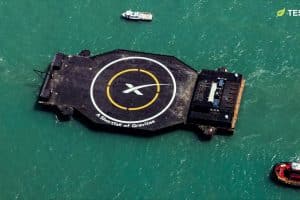For the second time ever, SpaceX has fully stacked a two-stage Starship rocket, once again creating the largest launch vehicle prototype ever assembled.
This time around, though, SpaceX used building-sized arms installed on Starbase’s ~145-meter-tall (~480 ft) ‘launch tower’ to lift to grapple Starship, lift massive upper stage more than 80 meters (260 ft) off the ground, and lower on top of a Super Heavy booster. After multiple days of apparent troubleshooting and false-starts and weeks of proof-testing with water bags weighing dozens to hundreds of tons, the giant robot seemed to perform perfectly, pausing only once during the ascent.
After holding Starship S20’s weight for about an hour and attaching two smaller stabilization arms to the side of the rocket, the Mechazilla arms began to lift Starship in earnest around 10:27 pm CST. Around 10:45 pm, with the tip of Starship S20’s nose just shy of the top of the launch tower, the lift reached its apogee – multiple SpaceX drones swarming the rocket to document the milestone.
At their peak, the tower’s arms then swung Starship about 45 degrees until it was directly above Super Heavy Booster 4’s interstage. The launch tower’s Starship quick-disconnect (QD) arm – responsible for connecting the upper stage to ground systems – then swung in, partially deploying and ‘grabbing’ Super Heavy to fully stabilize the booster. Finally, once the booster was secured and SpaceX was confident in the alignment of the two massive rocket stages, the tower arms carefully lowered Starship onto Super Heavy’s interstage, where several clamps grabbed onto the ship to fully mate the pair.
While the actual near-term utility of those arms remains ambiguous at best, their first successful use is an undeniably impressive technical achievement. SpaceX began assembling them less than nine months ago, beginning with the Starship QD arm around May 2021. SpaceX began installing the two main Mechazilla arms in October 2021, three months after assembly began. Just three months after that, all three have come together for the first time to lift and stack the world’s largest rocket.
Perhaps most impressive of all is that on the very first try, lifting Starship and stacking it on top of Super Heavy with the launch and integration tower took just three hours from the start of the lift to a fully mated rocket. Additionally, though SpaceX did get lucky with minimal wind, it’s also impressive just how little uncontrolled movement was visible as Starship hung in the air hundreds of feet above the ground. Virtually no swaying was visible, meaning that the arms were doing their job of stabilizing the massive rockets in a situation where even a gentle breeze could make stacking Starship with a crane far too risky.
CEO Elon Musk will now have one of the most impressive accomplishments in modern spaceflight as a backdrop when he presents an update on the same rocket, hopefully shedding light on Starship’s next steps and the roles Ship 20 and Booster 4 might play in them. Stay tuned for updates on the event, which is scheduled to begin no earlier than 8pm CST, February 10th (02:00 UTC 11 Feb).





